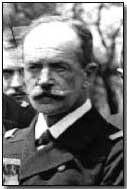Who's Who - Anton Haus
 Admiral Anton Haus (1851-1917) served
as the Austro-Hungarian navy's Commander in Chief during World War One,
combining the role with that of head of the War Ministry's Naval Section.
Admiral Anton Haus (1851-1917) served
as the Austro-Hungarian navy's Commander in Chief during World War One,
combining the role with that of head of the War Ministry's Naval Section.
Haus entered the Austro-Hungarian navy in 1869. Whilst acting as a
teacher at the Naval Academy in Fiume he published an influential textbook,
Oceanography and Maritime Meteorology. In 1900 he commanded a
corvette to Asia, and led the marine invasion of China during the Boxer
Rebellion, thereafter remaining in Peking until 1902.
Promoted to Vice-Admiral in 1907 Haus was appointed the Austro-Hungarian
delegate to the second peace conference in Haga the same year.
Haus was promoted to inspector of the fleet in 1912 and, following the
resignation of Admiral Monteccucoli in February 1913, was appointed Chief of
the Naval Group in the Ministry of War by the emperor,
Franz Josef; he
was simultaneously handed command of the Austro-Hungarian naval fleet.
Highly regarded as a naval strategist, Haus steadfastly - and in spite of
notable German criticism - maintained the view that Austria-Hungary's naval
position was best maintained by avoiding risk to the country's battlefleet
in risky offensive naval actions.
He successfully argued that his force was most effective when positioned as
a deterrent to Allied fleets in the Mediterranean. He was supported in
this view not only by his high command, but also by his successor,
Admiral Njegovan,
who retained the policy.
Promoted Great Admiral in 1916, Haus was one of relatively few
Austro-Hungarian commanders to come out firmly in favour of the German
policy of unrestricted submarine warfare.
He died of pneumonia on 2 August 1917 in Pola at the age of 66. His
place as Commander in Chief was taken by Admiral Njegovan.
A bunker comprised a fortification largely built below ground level.
- Did you know?
